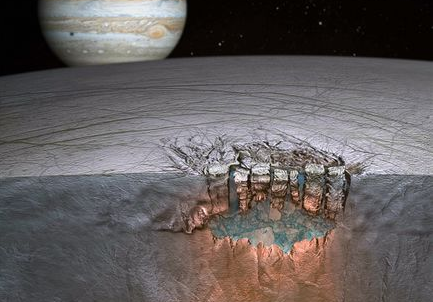Science News
Europa's Great Lakes
November 17, 2011

Sometimes it’s the little things, the bumpy little things…
Britney Schmidt, a postdoctoral fellow at the University of Texas at Austin, and her team were perusing data from the Galileo spacecraft. From 1995-2003, the Galileo mission studied Jupiter and some of its 64 moons, sending back a wealth of data that scientists are still studying today.
Several images of the icy moon Europa caught the team’s attention—especially those of roughly circular, bumpy features on its surface called chaos terrains. These chaos terrains looked familiar to the researchers, much like ice fields in Greenland and Antarctica here on Earth.
On our planet, these features correspond to ice shelves that sit on oceans or glaciers that cover volcanoes. The scientists wondered if the chaos terrains could be formed in similar ways and developed a model to test their theory.
Data from Galileo already suggested the existence of a saltwater ocean well below the surface of Europa—an ocean that contains more liquid water than all of Earth’s oceans combined! However, being so far from the Sun, the ocean surface is completely frozen. Most scientists think this ice crust is tens of miles thick.
“One opinion in the scientific community has been if the ice shell is thick, that’s bad for biology. That might mean the surface isn’t communicating with the underlying ocean,” said Schmidt at a NASA press conference yesterday.
But the bumpy surface could be good for biology. Schmidt’s model shows the chaos features on Europa’s surface may be formed by mechanisms that involve significant exchange between the icy shell and underlying lakes, equal in volume to North America’s Great Lakes.
These mechanisms could transfer nutrients and energy between the surface of the planet and the vast global ocean already inferred to exist below the thick ice shell. Which could increase the potential for life there.
“Now, we see evidence that it’s a thick ice shell that can mix vigorously and new evidence for giant shallow lakes. That could make Europa and its ocean more habitable,” reported Schmidt.
Still, because the lakes (if they exist) would lie a few miles below the surface, the only true confirmation of their presence would come from a future spacecraft mission designed to probe the ice shell.
So we’ll have to wait to confirm life on Europa, according to Wired.
Unfortunately, NASA does not currently have missions to explore Europa on its schedule… A proposed Jupiter-Europa Orbiter has an estimated price tag of $4.6 billion, making it unlikely to launch during a time of budget squeezes.
The research appears in the current edition of Nature.
Image: Britney Schmidt and Dead Pixel FX, University of Texas at Austin